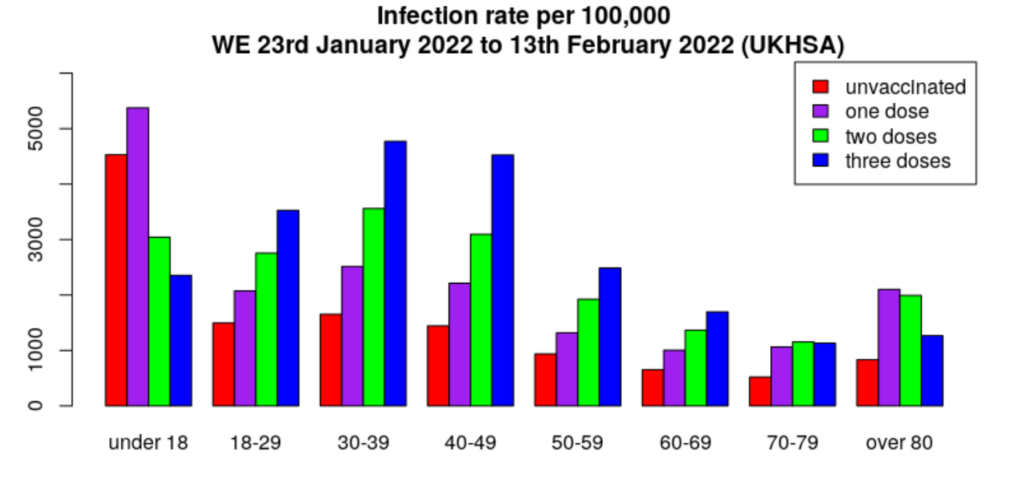
The big news in the last week was that the authorities in Scotland have decided that enough is enough; they’re going to stop publishing data on infections, hospitalisations and deaths by vaccine status. This isn’t surprising – the best way to stop people knowing that your public health interventions have failed is to stop giving them the information that will inform them that they have failed. Without these data the Scottish authorities can keep on saying that the vaccines are magnificent and have saved the nation, whereas the data suggest that even if they had some short term positive impact, they at best ‘paint a complex picture’.
At least in England there is still fairly good data being published on the performance of the vaccines, for now…
And onto this week’s update. I saw a good summary of the most recent UKHSA data on the Freedom Podcast Twitter feed:

From the Freedom Podcast Twitter feed
We’re clearly in a situation where the Covid vaccinations haven’t solved the Covid epidemic, and might even have made things worse (deaths). It certainly isn’t the case that this is a pandemic of the unvaccinated, when 72% of hospitalisations and 87% of deaths are in the vaccinated. Of course, the devil is in the detail, and in this specific case the variation between different age groups (older people are more likely to be vaccinated but also more likely to die). This week’s data indicate that infections continue to tumble for all age groups and vaccination status – the December and January Omicron wave appears to be receding fast. The data continue to show that for nearly all age groups the more vaccine doses you have the higher your risk of infection with Covid.
Two age groups stand out as different from the others – those aged under 18 and over 80. For those aged under 18 it is likely that the higher infection rate in the unvaccinated at least partially reflects their more recent vaccination (for all doses). It isn’t clear what is going on for those aged over 80 (and, to a certain extent, those aged 70-80). It is always worth remembering that the immune system of those under the age of about 12 and over the age of about 65 isn’t the same as for the majority of adults and you might expect to see different disease patterns and characteristics in these groups.
From the infection rate data we can again estimate the vaccine effectiveness against infection – negative for all age groups other than those aged under 18, and significantly so for those having taken a booster dose.
For this week we’ve got enough data to present graphs of vaccine effectiveness against time (this year) for all age ranges – as this is now rather a lot of data to present in one go I’ve split it into a graph for those aged under 50 and another for those aged over 50. First the changes with time for those aged under 50:

One dose of vaccine appears now to offer a relatively low but stable increase in the risk of infection, two doses offer a stable but higher risk of infection, while the risk of infection appears still to be increasing for those that have had a booster dose – those in their 40s being up to three times more likely to be infected than the unvaccinated. The silver lining in these data is that the impact of the vaccines in terms of increasing infection on those aged under 18 appears to be low; I hope that this reflects their robust innate immune system and isn’t simply because their recent vaccination means that there hasn’t been time for the increased risks to emerge.

The infections data for those aged over 50 paints a different picture. The only clear indication is that all age groups for any number of vaccinations have an increased risk of Covid, compared with the unvaccinated.
It is still unclear why the vaccine is resulting in increased risks of infection. There are several mechanisms that might explain it and really there should be much more research being done on this because they’ll determine the likely longer term outcomes of the vaccination programme.
